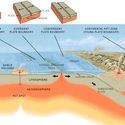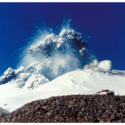We can blame plate tectonics for many catastrophes over time – earthquakes, volcanoes, geothermal1 activity, tsunamis2 and landslides – while people living on mountain ranges or small islands can thank the work of plate tectonics for providing them with somewhere to live. So what are tectonic plates3 and how do they cause all this change?
Before the 1960s, it was thought that continents4 were set in the same position forever. Realising the plates are dynamic5 led to new insights into our understanding of the planet6 and revolutionised and unified the Earth sciences – from the study of fossils (paleontology7) to the study of earthquakes (seismology8).
Explore this timeline to look at some of the historical aspects of earthquakes and find out how our understanding of what causes earthquakes has changed.
How do tectonic plates form and move?
The lithosphere9 (which includes the crust10) is the outermost layer of the Earth and is cooler and more rigid than the layer below. The asthenosphere11 underneath is hot and flexible, transferring some of its heat12 through convection13. In this case, the molten rock (magma14) moves towards the cooler section, welling up through 100 km deep cracks in the lithosphere. When the two sides of the crack move apart, the cooled rock forms new tectonic plate15 material.
Nature of science
In principle, all science knowledge is subject to change. Scientists have explained geology16 in many ways over time – from Aristotle's explanation in the 4th century BC that earthquakes derived from wind in subterranean caverns, to the early 20th century hypothesis17 of continental drift18, which led to the development of the tectonic plates theory19.
The plates ride on the asthenosphere, sometimes moving apart, sometimes past each other and other times moving together at plate boundaries. By using the global positioning system (GPS20) over a period of years, the plates have been measured as moving from a few millimetres to up to 20 cm per year. Over many millions of years, this can mean thousands of kilometres of movement.
Where are the tectonic plates?
The major plates are the Antarctic, African, Eurasian, Australian, Pacific, North American, South American and Nazca. There are also a number of minor plates, such as the Indian, Arabian, Caribbean and Philippine. Some plates (such as the Pacific plate) have only oceanic crust21, which is thinner and generally lies below sea level – others have both oceanic and continental crust22 that projects above sea level.
These plate boundaries are associated with geological events such as earthquakes and the creation of mountains, volcanoes and oceanic trenches. Most of the world’s active volcanoes occur along plate boundaries – the Pacific plate’s Ring of Fire23 is the most active.
New Zealand is right on the edges of two tectonic plates – the Australian and Pacific – and we get plenty of the action that goes with it!
Three types of plate boundaries
The plate boundaries are characterised by the way the plates move, and they are associated with different types of surface phenomena.
- Transform boundaries24 – The plates move past each other, but because of friction, they cannot just glide past each other so build up stress25, which is released as an earthquake. New Zealand’s Alpine Fault is an example of this type.
- Divergent boundaries26 – The plates slide apart from each other, and the space that this creates is filled with new crust from the magma formed below in the asthenosphere. These boundaries can create great fracture zones that are a major source of submarine earthquakes.
- Convergent boundaries27 – The plates slide towards each other. When one plate moves underneath the other, it is known as a subduction28 zone, associated with deep marine trenches and volcanoes – some of the most explosive on Earth.
Where two continental plates collide29 they either buckle and compress, or one plate will go under or override the other, creating extensive mountain ranges. When two plates with oceanic crust30 collide, they usually create an island as one plate is descending (subducting) beneath the other.
Related content
Find out more about Faults – a fracture in the Earth’s crust where the rock mass31 on either side has been displaced.
For younger students, see the resources mentioned in the On shaky ground article.
Activity ideas
Earthquakes New Zealand inroduces a series of activities designed to help students develop an understanding about earthquakes in New Zealand, including why we get them and how we measure them.
Check out our Earthquakes Pinterest board, it's full of ideas for additional resources.
Useful links
The purpose of GNS Science is to undertake research that enhances our understanding of geological and Earth system processes and increases Aotearoa32 New Zealand’s resilience to natural hazards and climate change33.
The GeoNet website provides public access to hazards information, including earthquake reports and Volcanic Activity Bulletins. You can also report earthquakes you've felt here.
See the Natural Hazards Commission Toka Tū Ake website (previously the Earthquake Commission (EQC). It's aim is to reduce the impact on people and property when natural disasters occur, by protecting homeowners and helping them recover from natural hazard events.
In these Radio NZ Our Changing World programmes from 2022 explore the research of scientists Digging into the past of sleeping giant faults and Finding faults and eavesdropping on earthquakes in Aotearoa New Zealand.
- geothermal: Geothermal energy is energy produced from the heat of the Earth.
- tsunami: A series of massive waves generated in the ocean usually by earthquakes, volcanic eruptions or submarine and coastal landslides, but they can also be caused by the impact of meteorites from outer space.
- tectonic plate: One of several large sections of the Earth’s crust. The Earth’s surface consists of six big tectonic plates and several smaller ones.
- continent: In geology, any of the main continuous expanses of continental crust on the Earth. Africa, Antarctica, Asia, Australia, Europe, North America and South America are recognised as continents, but this is based on historical and cultural attributes rather than geological attributes.
- dynamic: In science, a process or system characterised by constant change.
- planet: In our Solar System, a planet is defined as an object that orbits the Sun, is big enough for its own gravity to make it ball-shaped and keeps space around it clear of smaller objects.
- paleontology: The study of fossils.
- seismology: The study of earthquakes.
- lithosphere: The outer solid part of the Earth, made up of the crust and upper mantle. It varies in thickness and composition.
- crust: The outermost layer of the Earth. Estimated to be between 5–50 km thick. Made of solid rock of all types (metamorphic, igneous and sedimentary).
- asthenosphere: The layer of the earth within the upper mantle and directly below the lithosphere. This layer has a semi-solid consistency that reaches to 80 to 200 km below the surface.
- heat energy (heat): Heat energy: the transfer of energy in materials from the random movement of the particles in that material. The greater the random movement of particles the more heat energy the material has. Temperature is a measure of the heat energy of a material.
Heat: the flow of energy from a warm object to a cooler object. - convection: A method of moving heat energy. Found only in gases and liquids. Convection currents move heat from one location to another.
- magma: Molten rock that is found under the Earth and has not reached the surface. Formed from the Earth’s mantle and forms the lava that erupts from volcanoes.
- tectonic plate: One of several large sections of the Earth’s crust. The Earth’s surface consists of six big tectonic plates and several smaller ones.
- geology: Study of the origin, history and structure of the Earth; the geological features of an area.
- hypothesis: A tentative explanation for a fact or observation that can be tested.
- continental drift: A theory of land movement proposed by Alfred Wegener. All land is on massive continental plates that move due to the currents in the magma under the Earth’s crust.
- theory: To scientists, a theory provides a coherent explanation that holds true for a large number of facts and observations about the natural world. It has to be internally consistent, based upon evidence, tested against a wide range of phenomena and demonstrate problem solving.
- GPS: Global positioning system. Uses satellites, computers and receivers to determine the exact position of a receiver on Earth by calculating the time difference for signals from different satellites to reach the receiver.
- oceanic crust: Rock that makes up much of the surface lying under the oceans. It is more dense than continental crust and is typically made of basalt (an igneous rock).
- continental crust: Rock that lies under most of the Earth’s continents. It is less dense than oceanic crust and typically consists of igneous, sedimentary and metamorphic rocks.
- Ring of Fire: An area around the Pacific Ocean where large numbers of earthquakes and volcanic eruptions occur. It is home to over 75% of the world's active and dormant volcanoes.
- transform boundaries: An area where two tectonic plates meet and slide horizontally past each other. Crust is neither produced nor destroyed.
- stress: In mechanics, a force applied to a body.
In ecology and physiology, a response to a stimulus, e.g. an environmental factor, that disturbs or interferes with the normal equilibrium. - divergent boundaries: Tectonic plate boundaries, where new crust is generated as the plates pull away from each other.
- convergent boundaries: Tectonic plate boundaries, where crust is destroyed as one plate dives under another.
- subduction: When tectonic plates with differing material densities collide and the denser plate is forced down under (subducts) the less dense one.
- collide: When two or more objects, including particles, briefly come into contact with each other.
- oceanic crust: Rock that makes up much of the surface lying under the oceans. It is more dense than continental crust and is typically made of basalt (an igneous rock).
- mass: The amount of matter an object has, measured in kilograms.
- Aotearoa: The Māori name for New Zealand, meaning Land of the Long White Cloud.
- climate change: The large-scale, long-term increase in the Earth’s average temperatures, with associated changes in weather patterns. There is significant scientific evidence that warming is due to increased quantities of greenhouse gases in the atmosphere, with most of the rise due to human activity.








